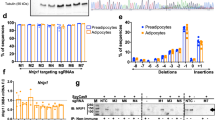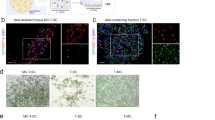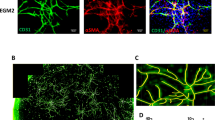Abstract
The accessibility of adipose tissue and its ability to secrete various bioactive molecules suggest that adipose cells may be attractive targets for gene therapy applications. Here, we report the use of highly defective herpes simplex virus (HSV) vectors as suitable gene transfer agents for adipose cells in culture and fat tissue in animals. Using an in vitro model of human adipose differentiation, we first demonstrated that mature adipocytes and their precursor cells express the two principal HSV viral entry receptors HveA and HveC (nectin-1) and are efficiently transduced at a low multiplicity of infection by HSV-lacZ reporter gene and glial cell line-derived neurotrophic factor (GDNF) gene vectors. Extended expression of β-galactosidase and secretion of GDNF occurred in transduced fat tissue explants from rabbits. In vivo gene transfer to rabbit subcutaneous adipose tissue resulted in local GDNF expression for at least 2 months. These experiments establish the efficient transduction of adipose cells by HSV vectors and suggest that fat tissue may represent a useful site for HSV-mediated gene delivery with potential for therapeutic applications.
This is a preview of subscription content, access via your institution
Access options
Subscribe to this journal
Receive 12 print issues and online access
$259.00 per year
only $21.58 per issue
Buy this article
- Purchase on Springer Link
- Instant access to full article PDF
Prices may be subject to local taxes which are calculated during checkout









Similar content being viewed by others
References
Frayn KN et al. Integrative physiology of human adipose tissue. Int J Obes Relat Metab Disord 2003; 27: 875–888.
Zuk PA et al. Multilineage cells from human adipose tissue: implications for cell-based therapies. Tissue Eng 2001; 7: 211–228.
Ryden M et al. Functional characterization of human mesenchymal stem cell-derived adipocytes. Biochem Biophys Res Commun 2003; 311: 391–397.
Burton EA et al. Multiple applications for replication-defective herpes simplex virus vectors. Stem Cells 2001; 19: 358–377.
Guo HL et al. Gene transfer of human manganese superoxide dismutase protects small intestinal villi from radiation injury. J Gastrointest Surg 2003; 7: 229–235; discussion 235–226.
Hauner H et al. Promoting effect of glucocorticoids on the differentiation of human adipocyte precursor cells cultured in a chemically defined medium. J Clin Invest 1989; 84: 1663–1670.
Spear PG, Longnecker R . Herpesvirus entry: an update. J Virol 2003; 77: 10179–10185.
Montgomery RI, Warner MS, Lum BJ, Spear PG . Herpes simplex virus 1 entry into cells mediated by a novel member of the TNF/NGF receptor family. Cell 1996; 87: 427–436.
Geraghty RJ et al. Entry of alpha herpesviruses mediated by poliovirus receptor-related protein 1 and poliovirus receptor. Science 1998; 280: 1618–1620.
Chen X et al. Herpes simplex virus type 1 ICP0 protein does not accumulate in the nucleus of primary neurons in culture. J Virol 2000; 74: 10132–10141.
Samaniego LA, Neiderheiser L, DeLuca NA . Persistence and expression of the herpes simplex virus genome in the absence of immediate-early proteins. J Virol 1998; 72: 3307–3320.
Hobbs II WE, DeLuca NA . Perturbation of cell cycle progression and cellular gene expression as a function of herpes simplex virus ICP0. J Virol 1999; 73: 8245–8255.
Everett RD . ICP0 induces the accumulation of colocalizing conjugated ubiquitin. J Virol 2000; 74: 9994–10005.
Lin L et al. GDNF: a glial cell line-derived neurotrophic factor for midbrain dopaminergic neurons. Science 1993; 260: 1130–1132.
Puskovic V et al. Prolonged biologically active transgene expression driven by HSV LAP2 in brain in vivo. Mol Ther 2004; 10: 67–75.
Goss JR et al. Herpes simplex-mediated gene transfer of nerve growth factor protects against peripheral neuropathy in streptozotocin-induced diabetes in the mouse. Diabetes 2002; 51: 2227–2232.
Ogata K et al. Expression of human coagulation factor VIII in adipocytes transduced with the simian immunodeficiency virus agmTYO1-based vector for hemophilia A gene therapy. Gene Therapy 2004; 11: 253–259.
Gnudi L et al. Adenovirus-mediated gene transfer of dominant negative ras(asn17) in 3T3L1 adipocytes does not alter insulin-stimulated P13-kinase activity or glucose transport. Mol Endocrinol 1997; 11: 67–76.
Magovern CJ et al. Regional angiogenesis induced in nonischemic tissue by an adenoviral vector expressing vascular endothelial growth factor. Hum Gene Ther 1997; 8: 215–227.
Levine JA, Jensen MD, Eberhardt NL, O'Brien T . Adipocyte macrophage colony-stimulating factor is a mediator of adipose tissue growth. J Clin Invest 1998; 101: 1557–1564.
Nagamatsu S et al. Adenovirus-mediated preproinsulin gene transfer into adipose tissues ameliorates hyperglycemia in obese diabetic KKA(y) mice. FEBS Lett 2001; 509: 106–110.
Tiraby C et al. Acquirement of brown fat cell features by human white adipocytes. J Biol Chem 2003; 278: 33370–33376.
Orlicky DJ, DeGregori J, Schaack J . Construction of stable coxsackievirus and adenovirus receptor-expressing 3T3-L1 cells. J Lipid Res 2001; 42: 910–915.
Vega RB, Huss JM, Kelly DP . The coactivator PGC-1 cooperates with peroxisome proliferator-activated receptor alpha in transcriptional control of nuclear genes encoding mitochondrial fatty acid oxidation enzymes. Mol Cell Biol 2000; 20: 1868–1876.
Mellerick DM, Fraser N . Physical state of the latent herpes simplex virus genome in a mouse model system: evidence suggesting an episomal state. Virology 1987; 158: 265–275.
Hao S et al. HSV-mediated gene transfer of the glial cell-derived neurotrophic factor provides an antiallodynic effect on neuropathic pain. Mol Ther 2003; 8: 367–375.
Wolfe D et al. Herpesvirus-mediated systemic delivery of nerve growth factor. Mol Ther 2001; 3: 61–69.
Natsume A et al. Bcl-2 and GDNF delivered by HSV-mediated gene transfer act additively to protect dopaminergic neurons from 6-OHDA-induced degeneration. Exp Neurol 2001; 169: 231–238.
Krisky DM et al. Deletion of multiple immediate-early genes from herpes simplex virus reduces cytotoxicity and permits long term gene expression in neurons. Gene Therapy 1998; 5: 1593–1603.
Maul GG, Everett RD . The nuclear location of PML, a cellular member of the C3HC4 zinc-binding domain protein family, is rearranged during herpes simplex virus infection by the C3HC4 viral protein ICP0. J Gen Virol 1994; 75 (Part 6): 1223–1233.
Parkinson J, Lees-Miller SP, Everett RD . Herpes simplex virus type 1 immediate-early protein vmw110 induces the proteasome-dependent degradation of the catalytic subunit of DNA-dependent protein kinase. J Virol 1999; 73: 650–657.
Gu H, Roizman B . The degradation of promyelocytic leukemia and Sp100 proteins by herpes simplex virus 1 is mediated by the ubiquitin-conjugating enzyme UbcH5a. Proc Natl Acad Sci USA 2003; 100: 8963–8968.
Bjorntorp P et al. Isolation and characterization of cells from rat adipose tissue developing into adipocytes. J Lipid Res 1978; 19: 316–324.
Nechad M et al. Development of brown fat cells in monolayer culture. I. Morphological and biochemical distinction from white fat cells in culture. Exp Cell Res 1983; 149: 105–118.
Chattopadhyay M et al. In vivo gene therapy for pyridoxine-induced neuropathy by herpes simplex virus-mediated gene transfer of neurotrophin-3. Ann Neurol 2002; 51: 19–27.
Krisky DM et al. Rapid method for construction of recombinant HSV gene transfer vectors. Gene Therapy 1997; 4: 1120–1125.
Nisoli E, Tonello C, Briscini L, Carruba MO . Inducible nitric oxide synthase in rat brown adipocytes: implications for blood flow to brown adipose tissue. Endocrinology 1997; 138: 676–682.
Acknowledgements
We thank Dr Simon Watkins and Laura Sysco for photographic imaging of adipose tissue, Joan Nash for assistance with animal studies,Will Seifred for technical assistance and Drs Harry Blair and Veronica Garcia for the use of the CryoJane® Tape-Transfer System. We thank Dr Patricia Spear (Northwestern University) for kindly providing the CHO-HveA and CHO-HveC cell lines and Drs Gary Cohen and Roselyn Eisenberg (University of Pennsylvania) for providing the CK6, CK41 and R140 Abs. This work was supported by a grant from Valentis corporation. JF was recipient of a fellowship from the Fonds de la Recherche en Santé du Québec (FRSQ, Canada).
Author information
Authors and Affiliations
Rights and permissions
About this article
Cite this article
Fradette, J., Wolfe, D., Goins, W. et al. HSV vector-mediated transduction and GDNF secretion from adipose cells. Gene Ther 12, 48–58 (2005). https://doi.org/10.1038/sj.gt.3302359
Received:
Accepted:
Published:
Issue Date:
DOI: https://doi.org/10.1038/sj.gt.3302359
Keywords
This article is cited by
-
Identification of genomic regions associated with feed efficiency in Nelore cattle
BMC Genetics (2014)
-
LIGHT is associated with hypertriglyceridemia in obese subjects and increased cytokine secretion from cultured human adipocytes
International Journal of Obesity (2010)
-
Characterization of Herpes Virus Entry Mediator as a Factor Linked to Obesity
Obesity (2010)
-
Development and application of replication-incompetent HSV-1-based vectors
Gene Therapy (2005)



